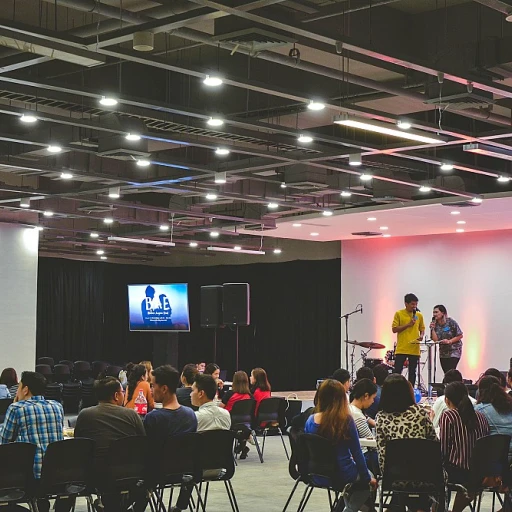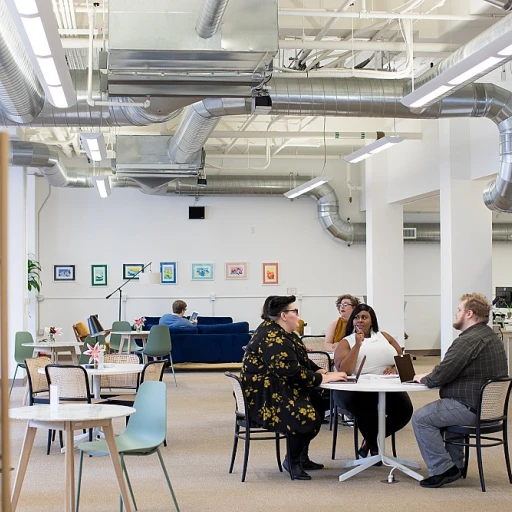
Understanding Talent Mobility
Talent mobility is rapidly becoming a cornerstone of modern organizational strategy, fundamentally reshaping how companies approach career development and talent management. At its core, talent mobility refers to the capacity for employees to navigate through different roles and opportunities within an organization. This dynamic approach offers a myriad of benefits, not just for the individual employees but also for the organization as a whole.
Emphasizing Internal Opportunities
For organizations aiming to leverage talent mobility, promoting internal mobility is key. This involves creating a robust framework where employees are encouraged to explore new roles and collaborative projects within the company. Such practices not only help in filling the existing skills gaps but also serve as a catalyst for employee engagement, ensuring that top talent feels valued and motivated. By fostering an environment where internal talent can thrive, businesses can deploy more effective talent strategies.
Bridging the Development Gap
One of the significant advantages of embracing talent mobility is its contribution to learning development. By actively encouraging employees to participate in mobility programs, companies can ensure continuous skill enhancement and growth. This aligns well with initiatives aimed at enhancing skills through learning and development opportunities, fostering a culture of learning that benefits both the employees and the business.
Nurturing a Future-Ready Workforce
By integrating a comprehensive mobility strategy, companies can adeptly manage their workforce in preparation for long-term goals. Preparing a future-ready workforce involves not just addressing immediate skill shortages but also anticipating the skills required in the years to come. Effective talent mobility strategies can position a company as a proactive entity in the eyes of both current and prospective employees, ultimately enhancing its employer branding.
The Role of Technology in Talent Mobility
The Transformative Influence of Digital Advancements
In the sphere of talent mobility, technology is increasingly playing a pivotal role. The digital transformation of businesses has ushered in tools and platforms that significantly streamline the processes associated with internal mobility and career development. For companies aiming to optimize their talent management strategies, harnessing technology becomes indispensable. Modern talent mobility programs leverage advanced analytics and AI-driven platforms to identify and match employees’ skills with available opportunities within the organization. These systems are empowering HR teams to pinpoint skills gaps and effectively address them through targeted learning development initiatives. This helps in cultivating a workforce that's not only adaptable but also primed for internal moves. Moreover, employee engagement is enhanced through digital channels that offer personalized career paths and learning opportunities. Platforms designed for talent marketplace solutions allow employees to explore roles they might not have previously considered, thereby opening doors to diverse career paths. For organizations, the integration of technology into their talent mobility strategy also translates to improved efficiency in managing global mobility challenges. By utilizing seamless communication and project management tools, international internal talent movement becomes less cumbersome. Embracing these digital tools also aligns with enhancing workplace culture, as tech-savvy employees often expect a digitally equipped work environment. For guidance on integrating wellness initiatives that complement digital programs and enhance overall organizational culture, explore enhancing workplace wellness here. In conclusion, technology's ever-evolving role in talent mobility is pivotal. As companies continue to adapt and thrive, leveraging tech for business and employee growth ensures a robust, future-ready workforce.Strategies for Effective Talent Mobility
Effective Practices to Enhance Internal Talent Movement
Creating a robust strategy for internal mobility involves several key components that can help organizations facilitate the efficient movement of employees across different roles and departments. Here's a look at some strategies that have proven successful for many businesses:
- Develop a Clear Mobility Program: Establish structured mobility programs that outline potential career paths and roles for employees. This clarity helps employees understand the available opportunities for career development within the organization.
- Leverage Technology and Platforms: Utilize talent management systems and talent marketplace tools to connect in-demand skills with the right roles internally. This kind of digital facilitation is central to effective talent mobility strategies.
- Promote a Culture of Learning: Encourage continuous learning development through customized learning and development programs. Embracing on-demand learning equips employees with the skills and knowledge required for new roles within the company.
- Create Transparent Processes: Transparency in internal moves can foster employee engagement. Clearly communicate how decisions are made regarding career advancements and role assignments.
- Identify and Address Skills Gaps: Regular assessments to identify skills gaps within the workforce can aid in creating targeted development activities. These assessments are essential to sustaining a successful mobility talent pool.
- Invest in Long-term Growth: A long-term view on career development cultivates loyalty and enables employees to grow alongside the business, thus supporting the overall mobility strategy.
Organizations looking to enhance their employer branding can find additional insights through evaluating performance review templates, which provide a framework for aligning employee progress with company objectives. For more information, check out enhancing employer branding with effective performance review templates.
Challenges in Implementing Talent Mobility
Overcoming Obstacles in Talent Dynamics
Navigating the intricate landscape of talent mobility presents several challenges for businesses. As companies strive to implement effective strategies, a myriad of hurdles can potentially disrupt the seamless transition of roles and skills within an organization. Organizations often face substantial internal skill gaps, which can thwart effective talent management plans. The lack of a coherent plan to bridge these gaps renders mobility programs less effective. Identifying and addressing these skills gaps is paramount for fostering an environment conducive to learning development and mitigating mobility challenges. Additionally, ensuring employee engagement is a significant barrier. Companies must cultivate an internal culture that prioritizes career development, making internal moves appealing. If employees feel stagnant or underappreciated, they are less likely to pursue new opportunities within the company. It's essential for businesses to create a talent marketplace that champions growth and recognizes potential, thereby encouraging internal talent mobility. A structured mobility strategy is crucial in addressing global mobility. Businesses must tailor their programs to account for cultural differences, regulatory hurdles, and logistical constraints associated with international roles. A global perspective, accompanied by a well-crafted strategy, can help organizations manage these complexities more efficiently. Furthermore, organizations often underestimate the long-term impact of an underdeveloped mobility program. Without strategic foresight and planning, mobility initiatives may fail to support employee career paths effectively, leading to talent attrition. Ultimately, overcoming these challenges requires a sustainable approach. By integrating best practices and aligning talent mobility with business goals, companies will facilitate a thriving internal talent ecosystem. This forward-thinking mindset not only strengthens the workforce but also enhances the overall employer brand, promoting a reputation that attracts and retains top talent.The Impact of Talent Mobility on Employer Branding
The Influence of Talent Mobility on Employer's Image
In today’s competitive landscape, companies recognize the significant influence of talent mobility on their employer brand. A strategic approach that prioritizes internal talent development and career opportunities can meaningfully enhance an organization's reputation.
Creating a dynamic internal talent marketplace not only fills roles more effectively but also showcases a company's commitment to employee growth. This commitment is crucial in attracting top talent, as prospective employees increasingly value companies that provide clear career development paths and invest in continuous learning.
Moreover, a well-structured mobility program helps bridge skills gaps by promoting internal moves, allowing companies to adapt swiftly to changing business needs without extensive external recruitment. This agility reflects positively on an organization’s brand, portraying it as a proactive and innovative entity.
Employee engagement, fostered by internal mobility, boosts loyalty and motivation, which in turn enhances the company’s public image. When employees feel valued and see possibilities for long-term growth, they become brand ambassadors, sharing their positive experiences and influencing external perceptions.
- Strengthening internal moves supports business resilience and showcases adaptability.
- A focus on learning development signals a future-ready, committed organization.
- Satisfied employees serve as credible spokespersons for the company brand.
In essence, a robust talent mobility strategy seamlessly integrates with broader talent management and employer branding objectives, helping organizations cultivate a reputation as desirable, progressive employers.
Future Trends in Talent Mobility
Adapting to Changing Talent Needs
The evolution of talent mobility is intricately tied to the changing landscape of skills development and employee roles. As companies navigate these shifts, they must adapt to the growing importance of internal mobility and the development of effective talent management strategies.- Internal Talent Pipelines: Organizations are placing increased emphasis on identifying and nurturing internal talent. By investing in learning and development programs, businesses can help employees grow into new roles, addressing skills gaps and enhancing their career paths.
- Flexible Career Paths: The modern workforce values flexibility and personalized career development opportunities. Companies that offer diverse career paths and encourage internal moves are better positioned to retain top talent and improve employee engagement.
The Growing Importance of Mobility Programs
Effective mobility programs are essential in facilitating the seamless transition of employees into new roles within the organization. These programs contribute to a company’s long-term growth and help cultivate a dynamic and engaged workforce.- Mobility Strategy Alignment: By aligning mobility strategies with overall business goals, companies can ensure that talent mobility efforts are not only effective but also contribute to the organization's success.
- Leveraging Technology: As highlighted earlier, technology plays a crucial role in streamlining talent mobility processes. From talent marketplaces to sophisticated talent management systems, technology aids in identifying potential internal candidates and facilitating their development.
Long-term Impacts on Employer Branding
Adopting a robust talent mobility strategy can significantly impact an employer’s brand. Companies that prioritize employee development and internal mobility demonstrate a commitment to their workforce, enhancing their reputation as desirable employers.- Employee Satisfaction and Engagement: By fostering a culture of growth and opportunity, organizations enhance employee satisfaction. This leads to better retention rates and positively influences how potential candidates perceive the company.
- Reputation as a Learning Organization: Emphasizing learning development and internal mobility portrays the company as a forward-thinking and supportive place to work, which is vital for attracting and retaining top talent.













